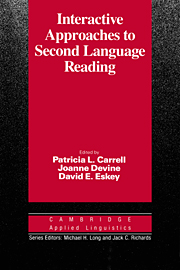Book contents
- Frontmatter
- Contents
- List of contributors
- Series editors' preface
- Preface
- Introduction: Interactive approaches to second language reading
- I INTERACTIVE MODELS OF READING
- II INTERACTIVE APPROACHES TO SECOND LANGUAGE READING – THEORY
- III INTERACTIVE APPROACHES TO SECOND LANGUAGE READING – EMPIRICAL STUDIES
- Chapter 9 A case study of two readers: models of reading and reading performance
- Chapter 10 Changes in cohesion in the recall of native and foreign texts
- Chapter 11 Reading English for specialized purposes: discourse analysis and the use of student informants
- Chapter 12 This test is unfair: I'm not an economist
- Chapter 13 The effects of induced schemata on the “short circuit” in L2 reading: non-decoding factors in L2 reading performance
- Chapter 14 The Miscue-ESL Project
- IV IMPLICATIONS AND APPLICATIONS OF INTERACTIVE APPROACHES TO SECOND LANGUAGE READING – PEDAGOGY
- Index
Chapter 9 - A case study of two readers: models of reading and reading performance
Published online by Cambridge University Press: 05 October 2012
- Frontmatter
- Contents
- List of contributors
- Series editors' preface
- Preface
- Introduction: Interactive approaches to second language reading
- I INTERACTIVE MODELS OF READING
- II INTERACTIVE APPROACHES TO SECOND LANGUAGE READING – THEORY
- III INTERACTIVE APPROACHES TO SECOND LANGUAGE READING – EMPIRICAL STUDIES
- Chapter 9 A case study of two readers: models of reading and reading performance
- Chapter 10 Changes in cohesion in the recall of native and foreign texts
- Chapter 11 Reading English for specialized purposes: discourse analysis and the use of student informants
- Chapter 12 This test is unfair: I'm not an economist
- Chapter 13 The effects of induced schemata on the “short circuit” in L2 reading: non-decoding factors in L2 reading performance
- Chapter 14 The Miscue-ESL Project
- IV IMPLICATIONS AND APPLICATIONS OF INTERACTIVE APPROACHES TO SECOND LANGUAGE READING – PEDAGOGY
- Index
Summary
The current assumption underlying much of the work in ESL reading is that research in second language reading as well as instructional materials should be based on a clearly articulated and consistently applied model of the reading process (see, for example, Rigg 1977, reprinted as Chapter 14 in this volume, and 1981; Clarke and Silberstein 1977; Hudelson 1981; Renault 1981). A “model” might best be understood as a set of assumptions about what happens when a reader approaches a text, that is, the ways a reader derives meaning from printed material. For the individual reader, a model of reading can be regarded as the guiding principles by which that reader will process available textual information. As Harste and Burke (1977) explain, a model of reading is a “system of assumptions through which experiences [in this case, the experience of confronting printed material] are organized and acted upon … [they are] schemata which govern behavior” (1977:32).
Studies of children learning to read in English have demonstrated the importance of readers' internalized models of the reading process (Harste and Burke 1977; Rhodes 1979). This research has identified at least three distinct theoretical orientations (or models) that readers hold; these models have been termed sound-, word-, and meaning-centered to indicate the language unit or focus that a reader considers important to good/effective reading. (See Figure 1.) When the models of reading that young readers held were later compared to samples of their oral reading, it was found that theoretical orientations affect both the ways reading is approached and to some extent the success of a reader in the recall and comprehension of that text (Rhodes 1979).
- Type
- Chapter
- Information
- Interactive Approaches to Second Language Reading , pp. 127 - 139Publisher: Cambridge University PressPrint publication year: 1988
- 12
- Cited by

